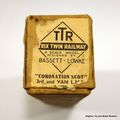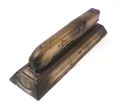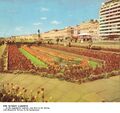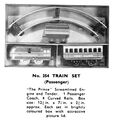Category:Art Deco
Art Deco is a style of architecture and industrial design that arguably reached its peak of popularity in Europe between World War One and World War Two, but persisted in American industrial design through the 1940s and into the 1950s. The style (along with Art Nouveau) is now often seen as being deeply evocative of the inter-war years.
Principles
Art Deco is difficult to define, but can be considered as a primarily sculptural style that makes heavy use of geometrical forms and symmetry. Curves are usually semicircular or quarter-circle arcs, there is an emphasis on right-angles and an avoidance of more acute angles, and major edges are often rounded-off with quarter-circle arcs or masked with cylindrical sections that replace what would otherwise be an edge. Curves are normally convex rather than concave, and where a protrusion appears too plain, "stepping" or spaced ridging is often used for decoration.
The resulting "rounded-edged block" design was easy to apply to domestic goods, and was perfect for mass-production using ceramics, moulded Bakelite or other early plastics as it allowed products to separate easily from their moulds, and allowed designers to easily produce stylised designs using the basic Art Deco principles.
In architecture, the style appeared widely in the UK in the design of cinema buildings of the period – these buildings needed to be highly visible landmarks, and had few or no windows above ground level, offering a large sculptable area. These architectural designs often featured heavily rounded corners, stepping and broad vertical central spine blocks, and often featured large blocks of cream or brown tiling influenced by the Glasgow architecture, producing a smooth and shiny surface that emphasised the geometrical nature of the design.
Towards the end of the 1930s, Art Deco symbolised modernity and mass-production's role in making designer goods and buildings available to the general population ("affordable luxury for all"), in an optimistic view of how people would live in the future. However, this utopian 1930s vision of Art Deco cities and transport was badly damaged by the pessimism and shortages engendered by World War Two, making the slightly cliche'd 1930s Art Deco "Cities of the Future!" conceptual designs seem naiive and dated.
Related styles
- Art Nouveau is another heavily stylised form whose period overlaps with Art Deco, but peaked in popularity a little earlier, in the 1920s. Art Nouveau has more emphasis on stylised organic and "fiddly" plant shapes, whereas Art Deco is more abstract. Art Nouveau styling appears in figurative sculptures and as surface decoration, but normally does not have the physical robustness of Art Deco when it comes to industrial design – one can easily visualise a single-colour Art Deco pop-up toaster, but an Art-Nouveau toaster would be more difficult to implement.
- Futurism was a predominantly German style, more aggressive, asymmetrical, disjointed and "pointy" than the blander Art Deco.
Exceptions
Most well-known Art Deco designs "break the rules", and depart from the extreme, "purist" Art Deco archetype in one way or another. In New York, the Chrysler Building is considered classic Art Deco with its elegant aluminium stepped spire, but the heavily-pointed tip is a departure from the standard "blunt" approach, and the almost plantlike, organic shape of the spire is perhaps entering Art Nouveau territory. The "clunky" stepping of the Empire State Building is very Art Deco, but perhaps a more purist implementation of the style might have used more curved "shoulders" on the stepping.
Subcategories
This category has the following 9 subcategories, out of 9 total.
A
- Astoria Theatre (2 F)
B
C
- Coronation Scot 1939 (3 P, 18 F)
D
E
- Embassy Court (1 P, 5 F)
S
- Saltdean Lido (4 F)
- Shoreham Airport (empty)
Pages in category ‘Art Deco’
The following 27 pages are in this category, out of 27 total.
C
- Clock for Overmantel (Nuways model furniture 8303)
- Coronation Class locomotive card model (Micromodels Set MII)
- Coronation locomotive 6220 (Bassett-Lowke)
- Coronation Scot carriage (Trix Twin Railway)
- Coronation Scot coach card model (Micromodels Set X)
- Coronation Scot First Class Brake Car 6202 (Exley for Bassett-Lowke)
- Coronation Scot First Class Car 7720 (Exley for Bassett-Lowke)
- Coronation Scot Kitchen Car 2704 (Exley for Bassett-Lowke)
- Coronation Scot Kitchen Car 2707 (Exley for Bassett-Lowke)
- Coronation Scot Restaurant Car 7507 (Exley for Bassett-Lowke)
- Coronation Scot Third Class Brake Car 7602 (Exley for Bassett-Lowke)
- Coronation Scot Third Class Car 4104 (Exley for Bassett-Lowke)
- Coronation Scot Third Class Car 4107 (Exley for Bassett-Lowke)
- Coronation Scot Third Class Car 5027 (Exley for Bassett-Lowke)
- Coronation Scot US Tour presentation set 2/347 (Trix Twin Railways)
L
Media in category ‘Art Deco’
The following 96 files are in this category, out of 96 total.
- 1939 New York Worlds Fair Coronation Scot brochure red.jpg 2,137 × 1,740; 1.14 MB
- 1939 pre New York Worlds Fair Coronation Scot brochure blue sketches.jpg 1,873 × 1,510; 489 KB
- 1939 pre New York Worlds Fair Coronation Scot brochure blue.jpg 1,889 × 1,508; 486 KB
- A Book of Trains (Puffin Picture Book).jpg 800 × 650; 118 KB
- Advert 1939 Mobiloil CoronationScot.jpg 300 × 393; 39 KB
- Bassett-Lowke catalogue 1937-38 CSblue back.jpg 908 × 603; 71 KB
- Bassett-Lowke catalogue 1937-38 CSblue front.jpg 910 × 611; 90 KB
- Bassett-Lowke catalogue 1937-38 streamliners.jpg 1,280 × 960; 244 KB
- Bassett-Lowke catalogue 1938-39 CSred back.jpg 911 × 607; 77 KB
- Bassett-Lowke catalogue 1938-39 CSred front.jpg 913 × 607; 95 KB
- Book TheDuchesses AndrewRoden.jpg 760 × 1,160; 87 KB
- Box end label for Coronation Scot carriage (Trix Twin Railway).jpg 800 × 799; 381 KB
- BTMM Coronation 6220 frontview TRD2012.jpg 2,000 × 1,500; 389 KB
- BTMM Coronation 6220 quarterview TRD2012.jpg 1,500 × 1,124; 275 KB
- Club Saloon Brake Compartment, Coronation Scot US tour (MRN 1939-03).jpg 836 × 1,200; 173 KB
- Club Saloon, Coronation Scot US tour (MRN 1939-03).jpg 1,200 × 944; 312 KB
- Coronation 6220 Bassett-Lowke ad 1939.jpg 4,324 × 1,802; 479 KB
- Coronation 6220 wings (Meccano Magazine).jpg 1,150 × 1,069; 129 KB
- Coronation Class - blueprint, front.jpg 768 × 1,024; 137 KB
- Coronation loco 6220, US tour, profile (MRN 1939-03).jpg 2,400 × 711; 324 KB
- Coronation loco Area 01.jpg 640 × 480; 187 KB
- Coronation Scot at BTMM logo.png 1,920 × 1,080; 169 KB
- Coronation Scot boardgame board.jpg 2,512 × 1,692; 915 KB
- Coronation Scot boardgame lid.jpg 800 × 500; 79 KB
- Coronation Scot cap-badge.jpg 800 × 335; 55 KB
- Coronation Scot in the United States.jpg 1,205 × 1,624; 428 KB
- Coronation Scot model, British Empire Exhibition (MRN 1938-09).jpg 1,800 × 966; 379 KB
- Coronation Scot nine-car train (Bassett-Lowke).jpg 1,200 × 562; 468 KB
- Coronation Scot publicity brochure, silver ink (LMS 1937).jpg 2,182 × 1,455; 533 KB
- Coronation Scot US (MRN 1939-03).jpg 2,400 × 2,339; 729 KB
- Coronation Scot US special-features p1.jpg 1,205 × 1,624; 405 KB
- Coronation Scot US special-features p2.jpg 1,205 × 1,624; 418 KB
- Coronation Scot US, special coaches (MRN 1939-03).jpg 2,400 × 834; 355 KB
- Coronation6220 blueprint side detail nose.jpg 1,728 × 2,355; 697 KB
- Coronation6220 HornbyR685 front.jpg 1,536 × 2,048; 260 KB
- Coronation6220 HornbyR685.jpg 1,024 × 768; 98 KB
- CoronationScot coach 1st HornbyR422.jpg 680 × 510; 43 KB
- CoronationScot GOSV 35c 01.jpg 955 × 714; 106 KB
- CoronationScot GOSV 35c 02.jpg 953 × 711; 140 KB
- Corridor First Lounge Coronation Scot US (MRN 1939-03).jpg 1,200 × 960; 310 KB
- Dolls House No49, Ultra Modern, Tri-ang 3135 (TriangCat 1937).jpg 1,301 × 1,480; 338 KB
- Dolls House No50, Ultra Modern, Tri-ang 3136 (TriangCat 1937).jpg 1,743 × 1,613; 420 KB
- Dolls House No51, Ultra Modern, Tri-ang 3137 (TriangCat 1937).jpg 1,969 × 1,477; 454 KB
- Dolls House No52, Ultra Modern, Tri-ang 3138 (TriangCat 1937).jpg 2,146 × 1,726; 621 KB
- Dolls House No53, Ultra Modern, Tri-ang 3139 (TriangCat 1937).jpg 2,489 × 1,802; 751 KB
- Duchess of Hamilton loco 6229, N gauge (Dapol).jpg 1,024 × 577; 111 KB
- Embassy Court (Brighton 2017).jpg 3,000 × 1,686; 2.31 MB
- Embassy Court - A New Design for Living (RoyalJubileeSP 1935).jpg 2,500 × 892; 249 KB
- Embassy Court - A New Design for Living, details (RoyalJubileeSP 1935).jpg 3,500 × 2,555; 2.04 MB
- Fireplace and Mantlepiece (Nuways model furniture 8302).jpg 2,894 × 2,092; 562 KB
- Gilbert Thomas and B-L Coronation 6220 (MRH12ed 1942).jpg 1,325 × 1,600; 464 KB
- Hornby Dublo City Station Outfit D2 (1939-).jpg 919 × 1,536; 243 KB
- Hornby R864 Coronation 6220 locomotive front-angle.jpg 1,536 × 1,536; 146 KB
- Hornby R864 Coronation 6220 locomotive side.jpg 1,024 × 768; 91 KB
- Hornby R864 Coronation 6220 locomotive tender.jpg 1,024 × 768; 74 KB
- Hornby-Meccano illuminmated shop display, detail.jpg 800 × 600; 266 KB
- Interior of First Class Sleeper, Coronation Scot US tour (MRN 1939-03).jpg 898 × 1,200; 194 KB
- LMS Coronation Scot small paperweight and box.jpg 1,632 × 1,224; 237 KB
- LMS Coronation Scot small paperweight.jpg 1,200 × 1,100; 89 KB
- LMS orange Coronation Scot poster (Bryan de Grineau).jpg 1,425 × 2,284; 647 KB
- LMS Power (book, Edward Talbot).jpg 473 × 600; 55 KB
- Locomotives, written by W.J. Bassett-Lowke, drawn by Paul. B. Mann.jpg 1,024 × 840; 133 KB
- Manyways 35, Quadrant Piece (TTRcat 1939).jpg 920 × 947; 69 KB
- Manyways 39, Tower Building (TTRcat 1939).jpg 989 × 1,373; 102 KB
- MeccanoMagazine June 1944.jpg 442 × 660; 54 KB
- MeccanoMagazine May1939 NewCoronationScot.jpg 480 × 647; 91 KB
- Micromodels Coronation Class locomotive MII angle.jpg 1,024 × 629; 71 KB
- Micromodels Coronation Class locomotive MII perspective.jpg 2,048 × 1,024; 208 KB
- Micromodels Coronation Class locomotive MII side.jpg 2,048 × 1,024; 225 KB
- Micromodels Coronation Scot carriage Set X.jpg 1,024 × 512; 63 KB
- Ocean Terminal, Minic Ships M841 (MinicShips 1960).jpg 1,585 × 1,304; 691 KB
- Pacific Steam (book, Martin Evans).jpg 664 × 1,056; 67 KB
- Red Coronation Class locomotive toy (TTI Stoke-on-Trent).jpg 960 × 768; 66 KB
- Red Coronation Scot jigsaw (Falcon).jpg 1,921 × 1,347; 315 KB
- Sunken Gardens, Angel of Peace (BHOG ~1961).jpg 2,500 × 2,364; 4.28 MB
- The Coronation Scot Ascending Shap Fell.jpg 1,665 × 1,363; 235 KB
- The Coronation Scot book cover Edward Talbot.jpg 360 × 463; 27 KB
- The Exhaust Steam Injector (Metcalfe's Patents).jpg 708 × 903; 143 KB
- The Prince, Streamlined Train Set, Wells Brimtoy 354 (BPO 1955-10).jpg 1,739 × 1,823; 965 KB
- The Romantic Story of the Iron Road (book, Cecil J. Allen).jpg 768 × 1,024; 139 KB
- TheCoronationScot RailwayGazette blueprint.jpg 1,024 × 447; 129 KB
- TheCoronationScot RailwayGazette cover.jpg 500 × 650; 43 KB
- TheTrackOfTheCoronationScot cover back.jpg 1,200 × 2,779; 172 KB
- TheTrackOfTheCoronationScot cover front.jpg 1,200 × 2,779; 165 KB
- TheTrackOfTheCoronationScot flyleaf.jpg 809 × 922; 63 KB
- TheTrackOfTheCoronationScot map.jpg 2,415 × 2,786; 717 KB
- TheTrackOfTheCoronationScot specifications.jpg 1,220 × 1,397; 285 KB
- Through Station D1, metal, Hornby Dublo (MM 1958-01).jpg 1,824 × 657; 185 KB
- TrixTwin CoronationScot.jpg 517 × 493; 39 KB
- TTR catalogue 1939-40 cover.jpg 1,722 × 2,820; 816 KB
- TTR Coronation Scot 1939 red US tour set.jpg 1,717 × 2,832; 643 KB
- Wonder Book of Railways (Coronation Scot), dustjacket.jpg 2,497 × 1,208; 638 KB
- Wonder Book of Railways (Coronation Scot), front.jpg 1,700 × 2,170; 543 KB






























































































